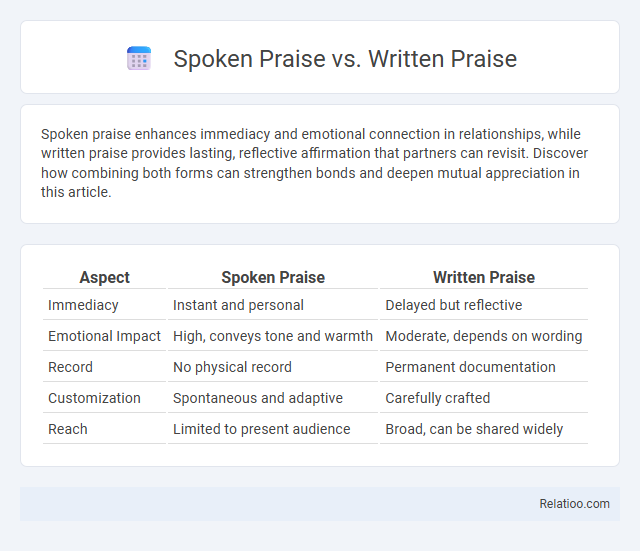Spoken praise enhances immediacy and emotional connection in relationships, while written praise provides lasting, reflective affirmation that partners can revisit. Discover how combining both forms can strengthen bonds and deepen mutual appreciation in this article.
Table of Comparison
| Aspect | Spoken Praise | Written Praise |
|---|---|---|
| Immediacy | Instant and personal | Delayed but reflective |
| Emotional Impact | High, conveys tone and warmth | Moderate, depends on wording |
| Record | No physical record | Permanent documentation |
| Customization | Spontaneous and adaptive | Carefully crafted |
| Reach | Limited to present audience | Broad, can be shared widely |
Introduction to Praise: Spoken vs Written
Spoken praise delivers immediate, personal feedback that enhances motivation and emotional connection, making your recognition feel more genuine and dynamic. Written praise provides a lasting record of achievement, allowing reflection and repeated reinforcement of positive behavior over time. Synchrony between spoken and written praise maximizes impact by combining emotional warmth with tangible evidence of success, strengthening overall effectiveness.
Defining Spoken Praise
Spoken praise involves verbal expressions of approval that convey immediate emotional connection and reinforce positive behavior through tone, inflection, and body language. Unlike written praise, which offers a tangible record and allows for thoughtful reflection, spoken praise promotes real-time synchrony between the giver and receiver, enhancing social bonding and motivation. Your understanding of spoken praise is essential for cultivating authentic, dynamic interactions that strengthen relationships.
Understanding Written Praise
Written praise offers a lasting and tangible record of achievement, enhancing motivation by allowing recipients to revisit and reflect on specific accomplishments. Unlike spoken praise, which may be fleeting or context-dependent, written praise provides clarity and precision, reducing ambiguity and increasing the perceived value of recognition. Synchrony in communication enriches praise impact, but written praise uniquely supports sustained encouragement and detailed feedback, vital for long-term personal and professional growth.
Psychological Impact of Spoken Praise
Spoken praise directly engages your brain's reward system by activating areas associated with social bonding and emotional processing, enhancing feelings of validation and motivation more intensely than written praise. The immediacy and tone of spoken praise create a synchrony in communication that fosters trust and strengthens interpersonal connections, which written praise often lacks due to its static nature. This dynamic interplay of verbal expression and emotional resonance makes spoken praise a powerful tool for reinforcing positive behavior and boosting self-esteem.
Psychological Impact of Written Praise
Written praise provides a lasting record that reinforces positive self-perception and boosts motivation by allowing individuals to revisit and internalize affirmations over time. Unlike spoken praise, which is transient, written praise enhances memory retention and cognitive processing, leading to more profound psychological benefits such as increased self-esteem and intrinsic motivation. This permanence also facilitates reflective practice, enabling continuous personal growth and resilience.
Situational Effectiveness: When to Use Each
Spoken praise is most effective in real-time interactions where immediate feedback boosts motivation and strengthens relationships, such as during meetings or performances. Written praise works well for creating lasting recognition, providing a tangible record that recipients can revisit, ideal for formal reviews or remote communication. Synchrony, combining both spoken and written praise, is situationally effective when reinforcing messages across multiple channels ensures clarity and maximizes impact, particularly in team environments or complex projects.
Long-Term Effects on Motivation
Spoken praise has an immediate impact on motivation by providing real-time feedback that reinforces positive behavior, while written praise offers lasting documentation that individuals can revisit to sustain motivation over time. Synchrony between spoken and written praise enhances long-term motivation by aligning verbal encouragement with tangible records, creating a consistent and credible reinforcement environment. Your sustained motivation benefits most when spoken praise is complemented by well-timed written recognition, maximizing both emotional engagement and cognitive reinforcement.
Personalization and Authenticity in Praise
Spoken praise delivers immediate, personalized feedback that enhances authenticity through tone, emotion, and context, making Your appreciation feel genuine and tailored. Written praise allows thoughtful reflection and permanence, offering a personalized message that can be revisited but may lack the spontaneous emotional nuances of speech. Synchrony in communication combines verbal and non-verbal cues, boosting the authenticity of praise by aligning timing, expressions, and gestures to reinforce Your sincere recognition effectively.
Common Pitfalls of Spoken and Written Praise
Spoken praise often suffers from vagueness and lack of specificity, which can reduce its motivational impact and lead to misunderstandings. Written praise may be too generic or insincere, lacking the emotional warmth that fosters genuine connection, and can be misinterpreted without vocal tone or facial expressions. Both forms risk inconsistency and overuse, diminishing their effectiveness compared to synchronous feedback that combines immediacy and clarity for optimal reinforcement.
Choosing the Right Form of Praise for Success
Choosing the right form of praise significantly impacts motivation and performance. Spoken praise delivers immediate emotional reinforcement, enhancing personal connection and engagement, while written praise provides lasting, tangible evidence of achievement that can be revisited for ongoing encouragement. Synchrony, blending both spoken and written praise, optimizes feedback by addressing diverse learner preferences and reinforcing positive behaviors consistently, boosting Your chances of sustained success.

Infographic: Spoken Praise vs Written Praise
 relatioo.com
relatioo.com